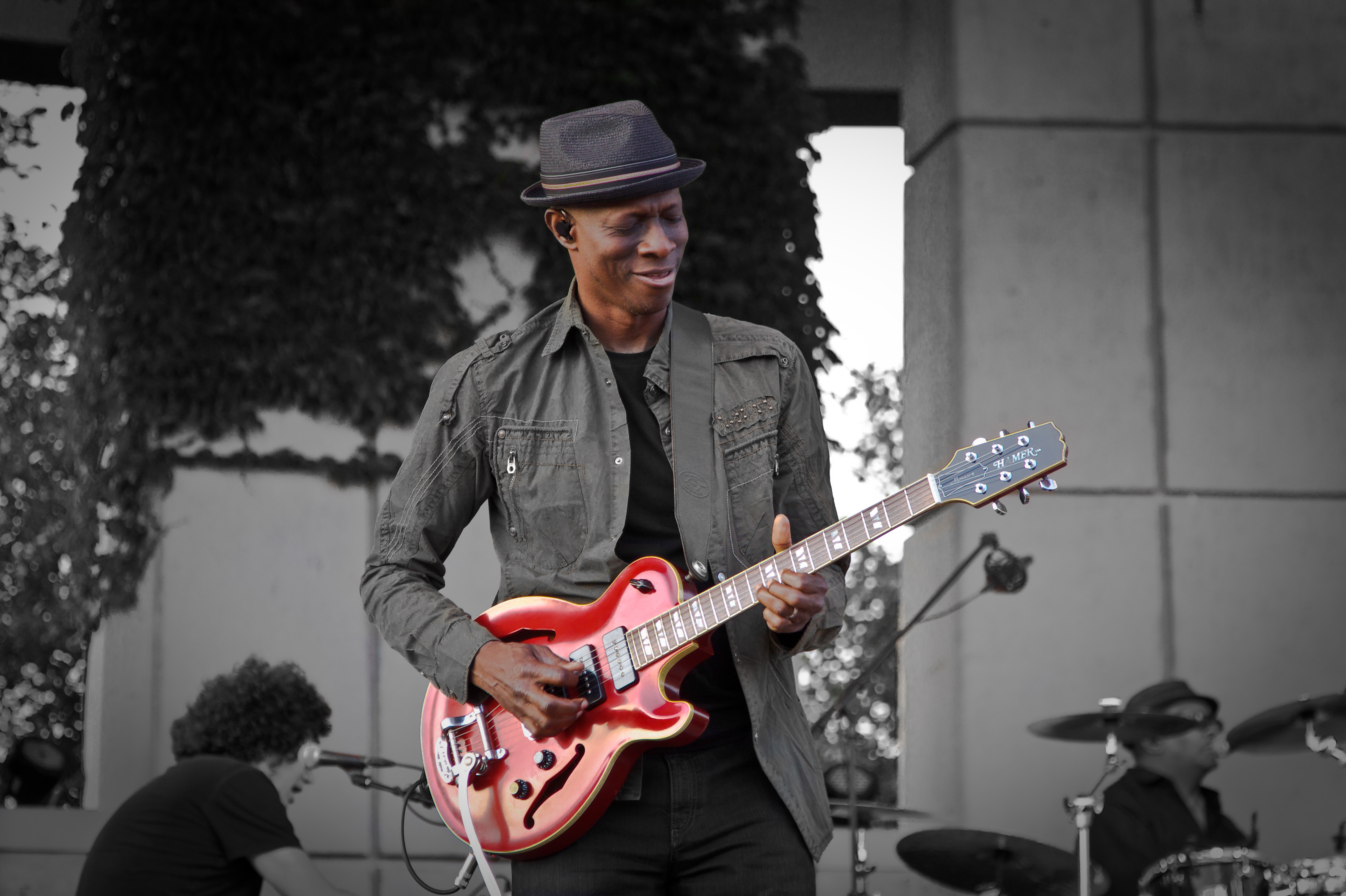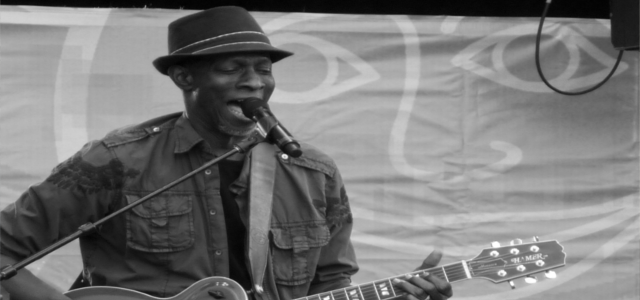First Published In The Music & Sound Retailer’s April 2007 Issue
In the tradition of “bluesmen” before him, including Muddy Waters (McKinley Morganfield) and Taj Mahal (Henry St. Clair Fredericks), Kevin Moore adopted a stage name early on in his career, embracing his African-American heritage and the phonetic spelling of his given name. As Keb’ Mo,’ he masterfully intertwines the spirit of the blues with the contemporary singer-songwriter movement. His ability to captivate broad audiences has earned him multiple Grammy awards and a reputation as the ultimate contemporary blues artist.
Kevin and I first met five years ago, but my wife has known him twice as long from when she worked for the Nice Jazz Festival in France where he performed. Being the warm and gracious gentleman he is, he instantly welcomed me into his life like an old friend. We have maintained that status ever since, developing a genuine friendship that goes well beyond our common interests as musicians. Three years ago, we started a “post NAMM hang” tradition. This year, the three of us went to dinner and then on a trip through “the hood” of East L.A. His son was performing at one club, and later Kevin graciously accepted to play a spontaneous set for a small but appreciative audience next door at the legendary Babes and Ricky’s Inn. Prior to the evening’s escapade, we sat in his living room and talked.
Ravi on behalf of The Music & Sound Retailer: Tell me about your first guitar?
Keb’ Mo’: It was from Sears and Roebuck—a Silvertone that cost $25. I hollered at my father to buy it for me so he did, but only after I had gotten two weeks of guitar lessons from my Uncle Herman, Herman Wyatt. I was able to use my uncle’s guitar during that time, but he lived in Northern California and I lived in Southern California, so when I got home, I needed a guitar. I was just 11 and couldn’t get a job, so I had to beg for one.
Ravi: Did you take any more lessons once you had your own guitar?
Mo’: I took three or four after that, but mostly I learned from my friend Stanley. He was taking lessons.
Ravi: What was your next guitar?
Mo’: I got my second guitar at a pawn shop—another Silvertone. I liked that Silvertone sound. I don’t know what it was, but it was a very “cost effective” guitar. The Fenders were always way out of my reach, but Silvertones and Kay Guitars were in my realm of financial possibility. So, my second guitar cost $50; a pawn shop guitar from Sears. It was an electric—a two pick-up job with a whammy bar.
Ravi: Do you still have your first?
Mo’: One like it. It’s not a replica, but it is one from the same line. In fact, I have both of them—the first and the second one—but not the actual ones that I had. I actually found them in different stores many years later. One I just got last year and the other I have had for about four years; I found one in Santa Monica at True Tone Music and the other in Chicago at a store called Midwest Buy and Sell.
Ravi: Did you just buy them for nostalgic reasons?
Mo’: No, I like the way they sound. There is something about those guitars. When I played them, I guess the sound was just very familiar.

Ravi: Do you use them professionally? How much did they cost?
Mo’: Yeah, I have one of the Silvertones out on the gig. Both of them were about $250 each. What’s interesting is that if you look at the price, they cost about the same as they did then, considering inflation. My first one was bought in 1963 and the second was probably around 1968.
Ravi: So, when was your first experience in a music store?
Mo’: Oh, I didn’t see a music store for a good while. There was a store in Compton (South Los Angeles): Compton Music Center run by the Blaylocks, a father and son. They had this little music store, and they had instruments, but everything was sold at retail and the prices were high. They had the Ventura line and Harmony Guitars. I don’t think they had any Fenders or anything like that. They had music lessons there so music teachers would come in and teach. I never bought anything there other than strings and picks, but the place inspired me. I took conga and guitar lessons there—about four on guitar and two on conga. I really was playing the conga drum and fancied myself as a percussionist. The guitar was something I did, but I was always wondering what instrument to play. I was in a steel band playing steel drums, so I was jumping from instrument to instrument, trying to find myself.
Ravi: Did you take any lessons beyond those four?
Mo’: I took French horn in junior high and high school, but in high school I got in a band and I was the rhythm guitar player. I learned most about how to play in that cover band—just a top 40 cover band playing dances.
Ravi: So, when did you get into blues?
Mo’: Oh, that came way later. That came after my pop career was over; when I realized that I was never going to have a pop career. I still wanted to play music, so I thought I’d play the blues since the music is real easy. I didn’t have to worry about rehearsing, the songs were easy, and people like to hear it.
Ravi: And look where it has taken you. What is this now, your 7th Grammy nomination?
Mo’: Let’s see, three hits, three misses…yup seven. I lost one for “Best Contemporary Blues Album,” another for “Best Children’s Record,” and last year for “Best Country Song” (a co-write with the Dixie Chicks). This year I am up for Best Contemporary Blues Album—I’ve won one three times in that category, but I think Susan Tedeschi is going to win. (Irma Thomas won).
Ravi: What does it mean to you to be nominated?
Mo’: It’s cool, but at this point, I’ve already won. At first it was great. I mean, I could say that it is an honor, and it is an honor, but it’s not as exciting as it was the first time. It’s just as big of an honor, but it’s not quite as exciting because now I have other things that I want to do, like music. With the Grammys, there are all these other things that go with it. You have to go to the Grammys, you have to buy something to wear, your wife’s got to get something to wear, and then there are the events that surround it.
Ravi: Do you think it gets away from what it is really about?
Mo’: No, no. But for me, I love to make music and that is what it is all about…making music. Going and getting an award for making music is an honor, but I’d rather be making music than receiving some award.
.jpg/640px-Keb'Mo_Band_(10653240894).jpg)
Ravi: What else do you use now on the gig?
Mo’: I play several different guitars. I’m all over the map with guitars, so it is hard for me to pinpoint a particular brand I like. Every brand has a guitar I like. As far as acoustics, I prefer the small bodied parlor-sized guitars—the 12th fret at the body type. I like the tighter sound. As far as electric guitars, I’m playing a Hamer right now. I also play Gibson, Epiphone, Fender, Silvertone, and of course National. I’m playing a ResoRocket on the gig now that resembles a tri-cone, but it is a single cone and it’s a cutaway. I like it because of the cutaway. You can slide up a bit further. For amps, I generally use a Mesa Boogie Mark IV. My favorite amps are the Boogie Mark IV and a Fender Deluxe—a blackface old Deluxe, not the real old tweed Deluxes, but the ‘60s Fender blackface. I also like the Full Tone distortion pedal. The MXR 6 band EQ, and that big blue triangular echo/chorus box (he was referring to the Visual Sound H2O Liquid Chorus and Echo pedal).
Ravi: What about Shure? I saw you play their NAMM party a couple of nights ago.
Mo’: Oh yeah, Shure in-ear monitors, and probably the most consistent things I use are Shure microphones. I use them for live gigs and surprisingly, a lot for recording. I also like the Groove Tube mic pre with the Shure SM-7 for vocals. For guitar, I like a B&K condenser mic. It sounds great through anything.
Ravi: Do you go into music stores these days?
Mo’: Yeah, I do, but I really like pawn shops. Used music stores I like. I like new stuff, but I like old stuff too. I really like old stuff—things that have withstood the test of time. New things are cool, but in my particular job in the blues, and being an old guy—well not an old guy, I’m only 55; it’s not like I’m about to die, I’m going to live a long time so 55 is very young—I tend to like things that are like me. They have a little time on them. It’s like clothes. When I go looking for clothes, I want something classic, nothing trendy and new. Classic, timeless things. Whether it is a new instrument or a used instrument, I’m looking for something that has a “classic” feel to it. It can be new, but things that are shaped like rockets and made of plastics or brand new materials or innovative designs, I tend to stay clear of. Even if it sounds great, I’d use it in the studio but I won’t take it out on the stage. It just doesn’t feel right. In the studio, no one sees it, but on stage, it’s theatrics. There is the element of theatrics to it. The instrument is your tool, but also your prop and part of your persona. So it has to reflect a lot of that. First, it has to play so your soul can come through on it, that’s No. 1. But I think it should have a look to it that reflects who you are.
Ravi: When I went to Portland last year, you told me to visit Carrie at the Portland Music Company, the Acoustic Shop.
Mo’: Yeah, my cousins live up there and the lady that runs it, Carrie, is a friend of the family and they happen to have a cool music store. So I like to go there and hang. They have a sofa in there and a lot of cool guitars. I sit and play and hang and every now and then I might even buy a guitar—once in a while.
Ravi: Do you think there are ways that music stores can better serve you?
Mo’: Yes, one thing they can do, and I won’t mention any names, but they can stop playing music in the store! That really annoys me, and I don’t really understand that. It creates a noisy atmosphere and you can’t really hear an instrument.
Ravi: What’s your best piece of advice for up and coming musicians?
Mo’: Be committed; be honest and be committed. Be committed to your art and your love of music, how that shapes up your music, and how that puts itself together for you in its own unique way. Each one of us is a unique individual that time has been waiting for—waiting for us to show up, and then we are gone.




